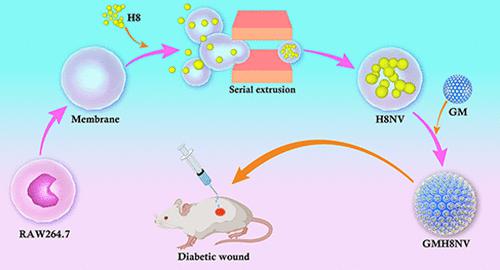当前位置:
X-MOL 学术
›
ACS Biomater. Sci. Eng.
›
论文详情
Our official English website, www.x-mol.net, welcomes your feedback! (Note: you will need to create a separate account there.)
Gelatin Microspheres Based on H8-Loaded Macrophage Membrane Vesicles to Promote Wound Healing in Diabetic Mice
ACS Biomaterials Science & Engineering ( IF 5.8 ) Pub Date : 2024-03-07 , DOI: 10.1021/acsbiomaterials.3c01742 Jiali Li 1, 2 , Yan Wu 1 , Qi Yuan 1 , Luxin Li 1 , Wenqi Qin 1 , Jia Jia 1 , Kaiyuan Chen 1 , Dan Wu 1 , Xiaohuan Yuan 1
ACS Biomaterials Science & Engineering ( IF 5.8 ) Pub Date : 2024-03-07 , DOI: 10.1021/acsbiomaterials.3c01742 Jiali Li 1, 2 , Yan Wu 1 , Qi Yuan 1 , Luxin Li 1 , Wenqi Qin 1 , Jia Jia 1 , Kaiyuan Chen 1 , Dan Wu 1 , Xiaohuan Yuan 1
Affiliation

|
Diabetic wound healing remains a worldwide challenge for both clinicians and researchers. The high expression of matrix metalloproteinase 9 (MMP9) and a high inflammatory response are indicative of poor diabetic wound healing. H8, a curcumin analogue, is able to treat diabetes and is anti-inflammatory, and our pretest showed that it has the potential to treat diabetic wound healing. However, H8 is highly expressed in organs such as the liver and kidney, resulting in its unfocused use in diabetic wound targeting. (These data were not published, see Table S1 in the Supporting Information.) Accordingly, it is important to pursue effective carrier vehicles to facilitate the therapeutic uses of H8. The use of H8 delivered by macrophage membrane-derived nanovesicles provides a potential strategy for repairing diabetic wounds with improved drug efficacy and fast healing. In this study, we fabricated an injectable gelatin microsphere (GM) with sustained MMP9-responsive H8 macrophage membrane-derived nanovesicles (H8NVs) with a targeted release to promote angiogenesis that also reduces oxidative stress damage and inflammation, promoting diabetic wound healing. Gelatin microspheres loaded with H8NV (GMH8NV) stimulated by MMP9 can significantly facilitate the migration of NIH-3T3 cells and facilitate the development of tubular structures by HUVEC in vitro. In addition, our results demonstrated that GMH8NV stimulated by MMP9 protected cells from oxidative damage and polarized macrophages to the M2 phenotype, leading to an inflammation inhibition. By stimulating angiogenesis and collagen deposition, inhibiting inflammation, and reducing MMP9 expression, GMH8NV accelerated wound healing. This study showed that GMH8NVs were targeted to release H8NV after MMP9 stimulation, suggesting promising potential in achieving satisfactory healing in diabetic treatment.
中文翻译:

基于负载 H8 的巨噬细胞膜囊泡的明胶微球促进糖尿病小鼠伤口愈合
糖尿病伤口愈合对于临床医生和研究人员来说仍然是一个世界性的挑战。基质金属蛋白酶 9 (MMP9) 的高表达和高炎症反应表明糖尿病伤口愈合不良。 H8 是一种姜黄素类似物,能够治疗糖尿病并具有抗炎作用,我们的预测试表明它具有治疗糖尿病伤口愈合的潜力。然而,H8在肝脏和肾脏等器官中高表达,导致其在糖尿病伤口靶向中的应用不集中。 (这些数据尚未发表,请参阅支持信息中的表 S1。)因此,寻找有效的载体以促进 H8 的治疗用途非常重要。使用巨噬细胞膜衍生的纳米囊泡传递的 H8 为修复糖尿病伤口提供了一种潜在的策略,可以提高药物疗效并快速愈合。在这项研究中,我们制造了一种可注射明胶微球 (GM),其中含有持续 MMP9 响应的 H8 巨噬细胞膜衍生纳米囊泡 (H8NV),其定向释放可促进血管生成,同时减少氧化应激损伤和炎症,促进糖尿病伤口愈合。 MMP9刺激的负载H8NV(GMH8NV)的明胶微球可以显着促进NIH-3T3细胞的迁移,并在体外促进HUVEC管状结构的发育。此外,我们的结果表明,MMP9 刺激的 GMH8NV 可以保护细胞免受氧化损伤,并使巨噬细胞极化为 M2 表型,从而抑制炎症。 GMH8NV 通过刺激血管生成和胶原蛋白沉积、抑制炎症和减少 MMP9 表达来加速伤口愈合。这项研究表明,GMH8NVs 在 MMP9 刺激后有针对性地释放 H8NV,这表明在糖尿病治疗中实现令人满意的治愈的潜力。
更新日期:2024-03-07
中文翻译:

基于负载 H8 的巨噬细胞膜囊泡的明胶微球促进糖尿病小鼠伤口愈合
糖尿病伤口愈合对于临床医生和研究人员来说仍然是一个世界性的挑战。基质金属蛋白酶 9 (MMP9) 的高表达和高炎症反应表明糖尿病伤口愈合不良。 H8 是一种姜黄素类似物,能够治疗糖尿病并具有抗炎作用,我们的预测试表明它具有治疗糖尿病伤口愈合的潜力。然而,H8在肝脏和肾脏等器官中高表达,导致其在糖尿病伤口靶向中的应用不集中。 (这些数据尚未发表,请参阅支持信息中的表 S1。)因此,寻找有效的载体以促进 H8 的治疗用途非常重要。使用巨噬细胞膜衍生的纳米囊泡传递的 H8 为修复糖尿病伤口提供了一种潜在的策略,可以提高药物疗效并快速愈合。在这项研究中,我们制造了一种可注射明胶微球 (GM),其中含有持续 MMP9 响应的 H8 巨噬细胞膜衍生纳米囊泡 (H8NV),其定向释放可促进血管生成,同时减少氧化应激损伤和炎症,促进糖尿病伤口愈合。 MMP9刺激的负载H8NV(GMH8NV)的明胶微球可以显着促进NIH-3T3细胞的迁移,并在体外促进HUVEC管状结构的发育。此外,我们的结果表明,MMP9 刺激的 GMH8NV 可以保护细胞免受氧化损伤,并使巨噬细胞极化为 M2 表型,从而抑制炎症。 GMH8NV 通过刺激血管生成和胶原蛋白沉积、抑制炎症和减少 MMP9 表达来加速伤口愈合。这项研究表明,GMH8NVs 在 MMP9 刺激后有针对性地释放 H8NV,这表明在糖尿病治疗中实现令人满意的治愈的潜力。



























 京公网安备 11010802027423号
京公网安备 11010802027423号